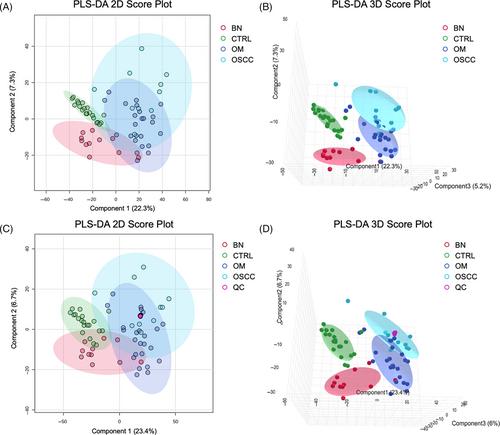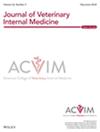Salivary metabolomic identification of biomarker candidates for oral melanoma and oral squamous cell carcinoma in dogs
Abstract
Background
Oral melanoma (OM) and oral squamous cell carcinoma (OSCC) are frequently diagnosed in dogs, presenting a challenge in distinguishing them from benign oral tumors (BN). Salivary metabolomic biomarkers offer a practical solution because of saliva's direct contact with tumors and the noninvasive nature of collection.
Objective
Assess the diversity and abundance of the salivary metabolome in dogs with BN, OM, and OSCC using amine/phenol submetabolome analysis and high-performance chemical isotope labeling liquid chromatography–mass spectrometry (CIL LC-MS).
Animals
Study included 11 BN, 24 OM, 10 OSCC, and 20 healthy control dogs.
Methods
Case-control cross-sectional study was conducted to assess salivary submetabolic profiles in dogs with BN, OM, and OSCC and healthy dogs. Samples were labeled with 12C-dansyl chloride and analyzed using CIL LC-MS targeted to amine- and phenol-containing metabolites for amine/phenol submetabolome analysis.
Results
Distinct clusters and significant differences in metabolite concentrations were observed among the oral cancer, BN, and control groups. A total of 154 and 66 metabolites showed significantly altered concentrations, particularly in OM and OSCC, respectively, when compared with BN (Padj < .05). Potential metabolic biomarkers were identified for each cancer, including decreased concentrations of seryl-arginine and sarcosine in OSCC. Moreover, high-confidence putative metabolites were identified, including an increase in tryptophyl-threonine and a decrease in 1,2-dihydroxynapthalene-6-sulfonic acid and hydroxyprolyl-hydroxyproline for OM.
Conclusions and Clinical Importance
We identified high coverage of the amine/phenol submetabolome, including seryl-arginine, and sarcosine, in OSCC. Our findings emphasize the potential of these biomarkers for distinguishing between oral OSCC and BN in dogs.


 求助内容:
求助内容: 应助结果提醒方式:
应助结果提醒方式:


